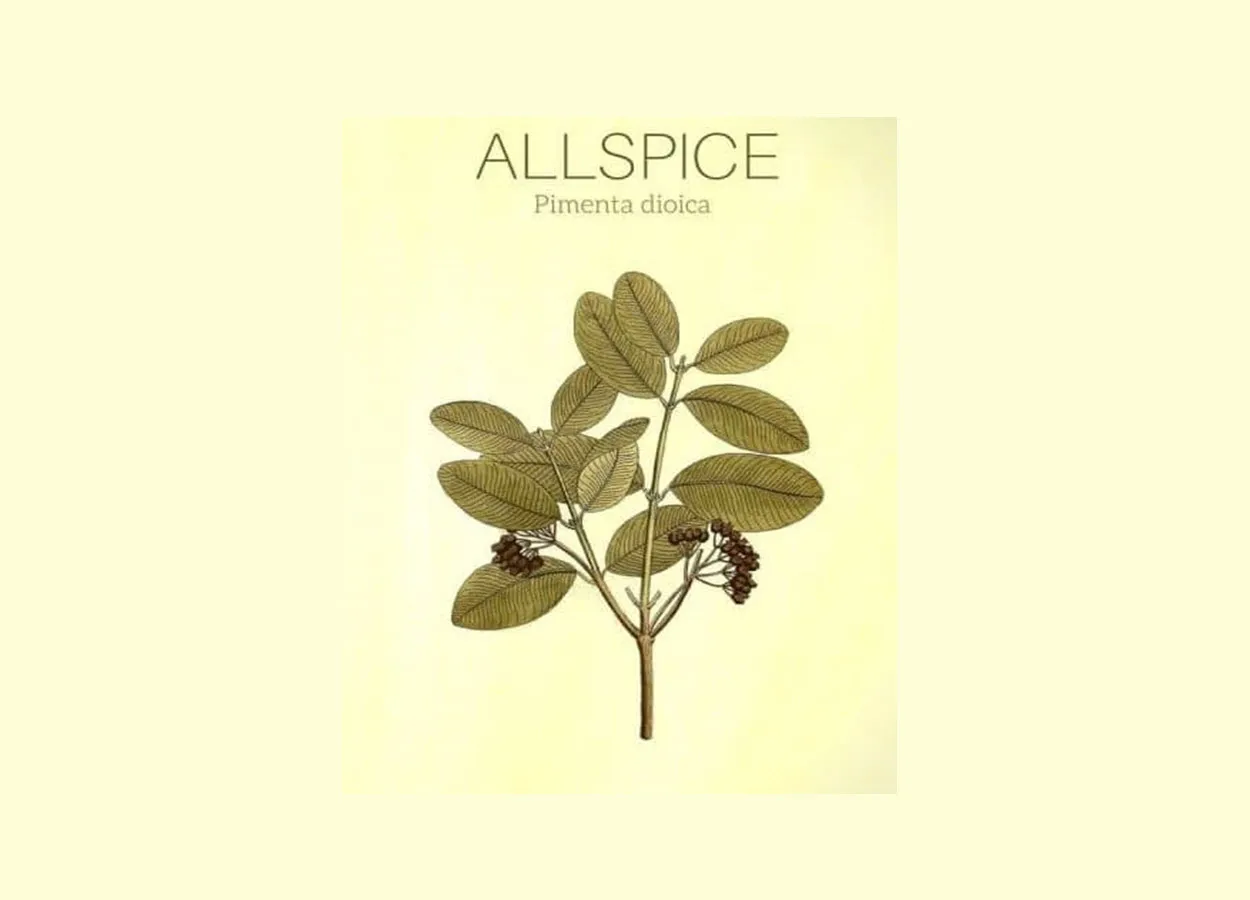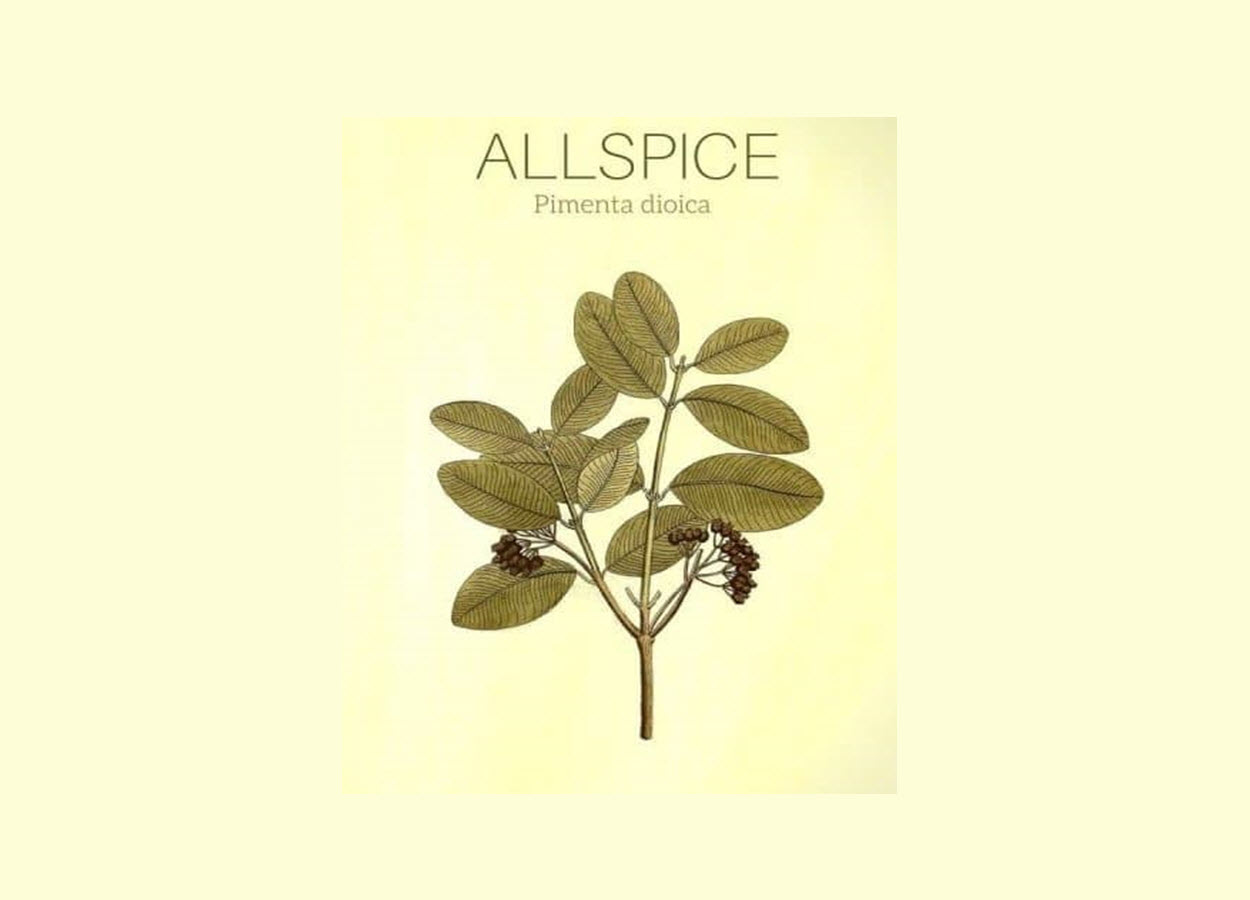
About Author
POOJA RAWAT
DEPARTMENT OF BIOTECHNOLOGY
DEENBANDHU CHHOTU RAM UNIVERSITY OF SCIENCE & TECHNOLOGY,
MURTHAL (SONEPAT) HARYANA
ABSTRACT
All through numerous times of history, spices have guaranteed consideration for their magical properties, either through ingesting or breathing in. What humanity has done all through an ideal opportunity to innovatively improve or lift the impression of his reality is a captivating subject. Truly flavors have appreciated a rich custom of utilization for their flavor-upgrade qualities and for their restorative properties. Pimenta Dioica an evergreen shrub was first discovered by Christopher, which is native to Jamaica but can now be found in other parts of the world (Priya S Rao, 2012 & Bown D, 2002). It is also known by the common name AllSpice due to its various flavours with the combination of cinnamon, nutmeg, cloves, pepper, juniper, and ginger (Peter K. V, et al,2000 & Davidson. A, 2006). Every part of this plant is used as medicinal or either as a spice in the food (Priya S Rao, 2012). Due to the medicinal effect of the AllSpices various studies has been done to ensure its therapeutic efficacy. Various chemical compounds are found which have different therapeutic effects like used in menopause treatments (Doyle B J, 2009), diabetic drug (Rebecca D, 2008), antioxidant properties (Singh G,2007 & Ramos A, 2003) antimicrobial properties (Singh G,2007 & Laekeman GM, 1990), cancer (Russell L H Jr, 2012) etc. The concept of these arose from the use of folk medicine by the native people of Jamaica, Caribbean. The word "pimento" is derived from the Spanish word "pimienta" for black pepper due to the resembles like peppercorns. It is known as pepper in many languages. The name ALLSPICE was coined by John Ray (1627–1705), an English botanist, who identified the flavour to a combination of clove, cinnamon and nutmeg (2, Davidson. A, 2006).
INTRODUCTION
Spices have been basically having importances in the culinary craft of seasoning nourishments since vestige. Aside from enhancing and flavouring, they are also utilized in indigenous meds, aromatherapy, pharmaceuticals, Nutraceuticals, additives, drinks, characteristic hues, scents, dental arrangements, beautifying agents and botanicals as a pesticide and subsequently, assume a critical job in the economy of the creating nation. These properties are because of an assorted cluster of synthetics incorporated by these flavours. As a rule, these phytochemicals capacity to pull in helpful and repulse destructive life forms fills in as photoprotectant and react to ecological changes. Flavors and fixings have been expended since the prehis-toric times to improve the flavor and taste of the cooked food. Spices are fragrant, sharp, flavoring operators by and large usedin little amounts.
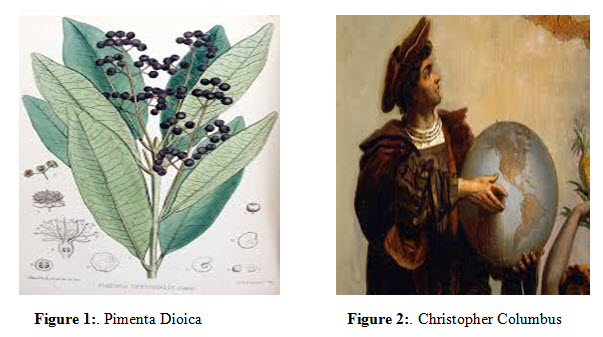
Pimenta dioica (Figure. 1 Pimenta Dioica) is a native plant from the Caribbean island Jamaica. (Priya S Rao, 2012, Weiss, E. A. 2002 & Sir Ghillean Prance, 2005). Pimenta dioica was acquainted into and dispatched with Europe in the sixteenth century (Bown D 2002, Vaughan JG,1997 & Davidson. A, 2006) It was the revelation of Christopher Columbus (Figure 2:. Christopher Columbus) during his journeys to the new world around the fifteenth century, accidentally found the Allspice in Jamaica and called Jamaican pepper (Zhang L, 2012 & Sir Ghillean Prance, 2005).
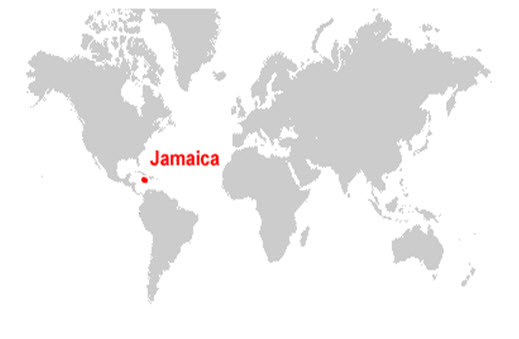
Jamaica is likewise the world's biggest maker of allspice and Jamaican allspice is eminent for being of outstanding quality since it contains a more significant level of basic oils, which give it more flavour that grows in other Caribbean (Lim T.L, 2012) Figure 3:. Jamaica on world map Some features of the tree are Leaves are straightforward, inverse, whole, elongated - circular, 6-20 cm long, accentuate with pellucid glands which emit the smell of the spies when squashed. The blossoms are little and whitish with an exceptional aroma (Priya S Rao, 2012).
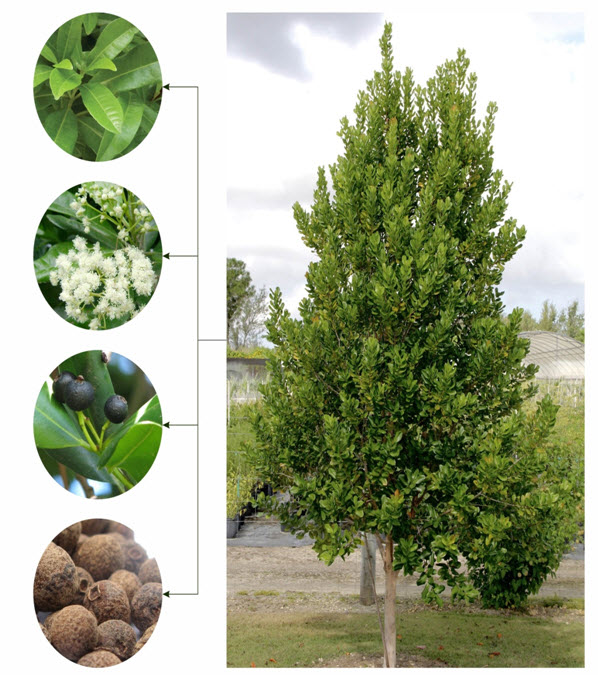
Figure 4:. Pimenta Dioica Tree (Magnifine image of Leaves, Flowers, Fruits & Seeds)
They are available in gatherings of cymes. Plants FLOWER during March-June. BERRY develops 3 to 4 months. The organic products have two kidney-moulded seeds. SEED is picked when it is completely formed and transformed into earthy coloured in the surface when they're dried and look like enormous peppercorns (Priya S Rao, 2012). Trees develop under the normal mean temperature of 18°C - 24°C (Priya S Rao, 2012). Pimento is a forest tree and its seedlings benefit from shading until established. Like clove, pimento may require quite specific environmental conditions to flourish. Pimenta dioica is widely planted in warm regions of the world as an ornamental plant valued for its fragrance and attractive habit. The word "pimento" is derived from the Spanish word "pimienta" for black pepper due to the resembles like peppercorns. It is known as pepper in many languages. The name ALLSPICE was coined by John Ray (1627–1705), an English botanist, who identified the flavour to a combination of clove, cinnamon and nutmeg (Peter K. V, 2000 & Davidson. A, 2006) Apart from its mesmerizing taste of earlier local uses Allspices as herbal medicine in the traditional way by drinking the water extract of Allspices, it was believed that the tree has the medicinal properties similar to clove and ajwain in various parts of the world after its distribution. The pharmacological capability of the basic oils and thought extracts obtained from these components have given in solid bioactive compounds, displaying possible antimicrobial exercises. The existing challenge lies in characterizing their advantages, concentration for organization, and strategies for application through scientific research. Depending upon the different geographical and ethnicity it leads to various the local practices of using any therapeutic flora where its herb, shrub or tree, same likely happen in the case of allspice also that native Jamaican use Allspice in there hot tea for dyspepsia, for cold and dysmenorrhea. Whereas people of Guatemalans treat bruises, sore joints and for myalgia (muscle ache). Few other herbal mixtures along with allspice were used to relieve indigestion by Cuban people. According to Ayurveda to relieve respiratory congestion and assorted odontalgia. (toothache was used by Indians). In Turkey, it is used as an aphrodisiac when taken along with honey. Caribbean people use Allspice berries for folk healing. Costa Ricans are known to use Allspice to treat dyspepsia and diabetes. In Europe, anecdotal uses of Allspice extract for dyspepsia and as purgative exist. In 1898 its incorporation in the British Pharmacopoeia of 1898, especially of pimento oil and pimento water. Apart from the various local benefits, it has its various local common names, enlisted in table 1 (Vernacular names of allspice (Pimenta dioica).
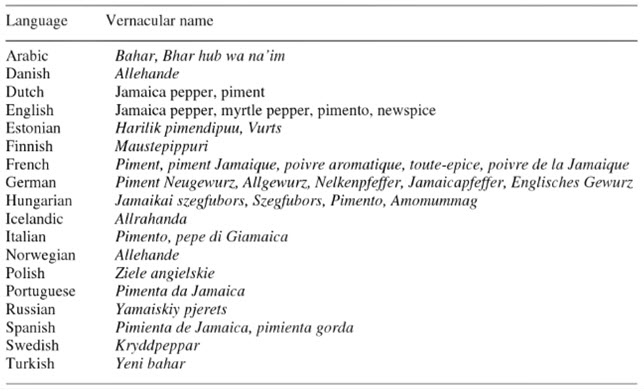
Table 1: Vernacular names of allspice (Pimenta dioica)
Botanical classification

Domain : Eukaryota
Kingdom : Plantae
Phylum : Spermatophyta
Subphylum : Angiospermae
Class : Dicotyledonae
Order : Myrtales
Family : Myrtaceae
Genus : Pimenta
Species : Pimenta dioica
REVIEW OF LITERATURES
APPLICATION IN VARIOUS PHARMACEUTICAL FIELD
Menopause Treatment
A clinical study shows that the Menopause symptoms affect in women from Maya or costa Rica was very low as compared to the U.S., where approximately 70-75% of women approaching the hormone replacement therapy (HRT) as the standard of care to overcome the menopause effect. The reason for having delayed menopause effect in Maya or Costa Rica women was due to plant-based dietary which includes herbal medicines in day to day life. (Locklear T D, 2007). for the treatment of menopause, pimenta dioica was one of the ethnomedical which is used as dietary herbal medicine which has the methanol extract that acts as partial agonist/antagonists to intensify estradiol that stimulated pS2 mRNA expression (Doyle B J, 2009).
Antimicrobial Activity
Pimenta dioica has about 60-90 % of eugenol present in them which inhibit the growth of many pathogens (Zhang L, 2012). It has both antibacterial and antifungal activities. (Singh G,2007) Eugenol and analogues also have antiviral activity also it was observed against polio type I, Coxsackie B2, and herpes simplex type I was analysed through the endpoint titration technique (EPTT) ( Laekeman GM, 1990). Due to the antimicrobial activities, Allspices is used as folk practices in food fumigant to preserve freshness and sterility of meat and poultry products [Zhang L, 2012]. Apart from this Allspice, essential oils have been used as a natural pesticide and fungicide for woods and plant (Zabka M, 2009). Allspice berry oil showed good nematicidal activity at 2mg/ml against the pinewood nematode, Burasa-phelenchus xylophilus (Park I.K, 2007).
Antioxidant Activities
Sometimes the overproduction of Oxygen free radicals causes biological damage. Oxidative stress cause damage to DNA & proteins which leads to pathological conditions involving cancer, neurological disorders, cardiovascular disease, diabetes, ageing and other chronic and fatal diseases (Zhang L, 2012) herbs and spices are always rich in antioxidants and equal to those fruit and vegetables in terms of consumption. Allspice is also known for its antioxidant activities [Ramos A, 2003 & Singh G,2007] the main reason of it was present of few compounds like Eugenol, Gallic acid, Quercetin and others (Padmakumari KP, 2011, Kikuzaki H, 2000 & Miyajima Y, 2004) The ethyl acetate extract of All-spice which contained polyphenols show strong antioxidant activities and free radical-scavenging activity against DPPH radicals [Singh G, 2007]. Many already known compounds are isolated from leaves and berries of Pimenta dioica, with antioxidant properties, such as Eugenol [Laekeman GM, 1990], Quercetin [Singh G, 2007], Gallic acid (Zabka M, 2009) and others. Due to the antioxidant properties, it was found that Pimenta dioica have Xanthine oxidase inhibiting properties along with the superoxide scavenging which is found to be very high (Jirovetz L, 2007).
Anticancer Activity
Due to the strong presence of antioxidants in p.dioica it has a beneficial effect on cancer Because of the generally enormous number and substance of aro¬matic and cell reinforcement mixes present in Allspice, several bunches have endeavoured to segregate and portray potential hostile to tumour specialists in Allspice and Pimenta leaves. The absence of new leaves and potential for change in content because of the dirt conditions in places where Pimenta trees are developed, set number of studies have been done on leaves versus that of Pimenta berries. In Tibetan remedy PADMA 28 it was observed that pimento dioica induce apoptosis in T cell-derived lymphocytic leukaemia cell line CEM-C7H2 (Jenny M, 2005).
From Allspice A glucoside extracted has been utilized as a functioning element of cancer-causing agent advertiser inhibitors. The glucoside is accounted for to repress Epstein-Barr infection early antigen arrangement. (Priya S Rao, 2012). Compounds like Eugenol, Quercetin, pedunculigan and Gallic corrosive, all of them show antiproliferative exercises on many built-up human tumour cell lines, including breast cancer, and prostate malignant growth cell lines (Russell L H Jr, 2012).
Some other Benefits of AllSpices
Ground Jamaican Pimento berries have been accounted for to repress protein glycation demonstrating its capability to be utilized as a compelling antidiabetic specialist (Rebecca D, 2008).
Central America people use to take Allspices as a folk medicine for the treatment of weight-related problems and high blood pressure. They also used it for indigestion related problem because it might due to the presence of Eugenol which helps in digestion by secreting the enzymes in the stomach (Kamatou GP, 2012).
Apart from this AllSpice oil is used as a local anaesthetic by the dentist because the eugenol gives an analgesic effect. Eugenol has potential anti-inflammatory effects also ( Kamatou GP, 2012).
Pimenta Leaves Aqueous extract has to revel hypotensive action which leads to lowering in blood pressure but besides that, it has a depressant effect on Central Nervous System (Suárez A, 1997).
CONCLUSION
Considering consumers’ safety, there have been continuous efforts by scientists to introduce complementary antimicrobialagents and achieve partial use of chemical preservatives andantibiotics. The Jamaican pepper plant Pimenta dioica contains has various benefits upon seening the folkal use of the tradition on these bases various tratments has been arosed and asseced practically in the labs as in vivo and in vitro testing, but still no clinical trails has been done to assure the therapeutic index for example in the case of Cancer. A few microscopic organisms that demonstrate protection from conventional antibiotics are discovered powerless to basic oils and concentrates of Allspices. It has been demonstrated through research facility study (in vitro) that there is high plausibility of using these constituents as potential antimicrobial operators. Least hindrance focus is awell-characterized and globally acknowledged strategy for testing antimicrobial action against pathogens. There are numeroususes of this procedure and frequently has been utilized in the scientific exploration to figure the portion of administrating drugs to the base usage of dynamic fixings.We have introduced a basic assessment of its restorative properties with exceptional consideration as a chemo-dietary avoidance specialist for constant maladies and threatening malignant growths. A few mixes abundantly found in Allspice, to be specific Quercetin, Gallic corrosive and Ericifolin show both in vitro and in vivo antiproliferative and antitumor exercises. Openings exist to distinguish a few potential anticancer mixes from Allspice and test their bioavailability and component of activity on typical and tumor frameworks. The safety guidelines are already included all in all pharmaceutical enactment.
REFERENCES
• Priya S Rao, Sheth Navinchandra , KN Jayaveera, An important spice, Pimenta dioica (Linn.) Merill: A Review.” International Current Pharmaceutical Journal 2012, 1(8): 221- 225
• Peter K. V,. Rema J. and Krishnamoorthy B, Indian Institue of of spices of India, Wood head publishing Limited, Handbook of Herbs and Spices, 2000.
• Lim T.L, Spinger, Edible Medicinal And Non Medicinal Plants: Volume 3, Fruits
• Weiss E. A. 2002. CABI Publishing 2002, New York Spice Crops..
• Bown D.The Royal Horticultural Society Encyclopedia of Herbs & their Uses. 3rd ed. London: Dorling Kindersley; 2002.
• Vaughan JG. Geissler C. The New Oxford Book of Food Plants: a Guide to the Fruit, Vegetables, Herbs and Spices of the World. London: Oxford University Press; 1997.
• Zhang L, Lokeshwar BL. Medicinal Properties of the Jamaican Pepper Plant Pimenta dioica and Allspice. Curr Drug Targets. 2012; 13(14):1900-1906.
• Davidson, A. The Oxford Companion to Food. 2nd ed. Oxford:Oxford University Press; 2006.
• Sir Ghillean Prance, Mark Nesbitt, Great Britain by routledge : The culture history of plants,1rst ed. 2005,
• Locklear TD, Doyle BJ, Caceres A, Perez A, Mahady GB. Menopause, a universal female experience, lessons from central America. Curr Rev Womens Health 2007;4:1-10.
• Doyle BJ, Frasor J, Bellows LE, et al. Estrogenic effects of herbal medicines from Costa Rica used for the management ofmenopausal symptoms. Menopause 2009; 16: 748-55.
• Singh G, Maurya S, deLampasona MP, Catalan CAN. A comparison of chemical, antioxidant and antimicrobial studies of cinnamon leaf and bark volatile oils, oleoresins and their constituents. Food ChemToxicol 2007; 45: 1650-61.
• Laekeman GM, Van Hoof L, Haemers A, Berghe DAV, Herman AG, Vlietinck AJ. Eugenol a valuable compound for in vitro experimental research and worthwhile for further in vivo investigation. Phytother Res 1990; 4: 90-6.
• Zabka M, Pavela R, Slezakova L. Antifungal effect of pimento dioica essential oil against dangerous pathogenic and toxinogenic fungi. Ind Crop Prod 2009; 30: 250-3.
• Park I.K., Kim J., Lee S.G., Shin, S, C. (2007). Nematicidal Activity of Plant Essential Oils and Components From Ajowan (Trachyspermum ammi), Allspice (Pimenta dioica) and Litsea (Litsea cubeba) Essential Oils Against Pine Wood Nematode (Bursaphelenchus Xylophilus). J Nematol. Volume 39, Issue 3, Pages 275-279. PMID: 19259498
• Ramos A, Visozo A, Piloto J, Garc A, Rodr CA, Rivero R. Screening of antimutagenicity via antioxidant activity in Cuban medicinal plants. J Ethnopharmacol 2003; 87: 241-6.
• Padmakumari KP, Sasidharan I, Sreekumar MM. Composition and antioxidant activity of essential oil of pimento (pimenta dioica (L) merr.) from jamaica. Nat Prod Res 2011; 25: 152-60.
• Miyajima Y, Kikuzaki H, Hisamoto M, Nikatani N. Antioxidative polyphenols from berries of pimenta dioica. BioFactors 2004; 21: 301-3.
• Kikuzaki H, Sato A, Mayahara Y, Nakatani N. Galloylglucosides from Berries of Pimenta dioica. J Nat Prod 2000; 63: 749-52.
• Jirovetz, L., Buchbauer, G., Stoilova, I., Krastanov, A., Stoyanova, A and Schimdt, E. (2007). Spice Plants: Chemi-cal composition and antioxidant properties of Pimenta Lindl. Essential oils, Part 1: Pimenta dioica (L.) Merr., leaf oil from Jamaica. ErNährung/Nutrition. Issue 2, Pages 55-62.
• Jenny, M., Schwaiger, W., Bernhard, D., Wrulich, O., Cosaceanu, D., Fuchs, D and Ueberall, F. (2005). Apoptosis induced by the Tibetan herbal remedy PADMA 28 in the T cell-derived lymphocytic leukaemia cell line CEM-C7H2. Journal of Carcinogenesis. Volume 4, Page 15.
• Rebecca, D, Greenspan, P., Hartle, D., Swanson, B, R and Hargrove, J. L. (2008). Inhibition of protein glycation by extracts of Culinary herbs and spices. Journal of medicinal food. Volume 11, Issue 2, Pages 275-281.
• Kamatou GP, Vermaak I, Viljoen AM. Eugenol—From the Remote Maluku Islands to the International Market Place: A Review of a Remarkable and Versatile Molecule. Molecules 2012; 17: 6953-81.
• Suárez A, Ulate G, Ciccio JF. Cardiovascular effects of ethanolic and aqueous extracts of Pimenta dioica in Sprague-Dawley rats.J Ethnopharmacol 1997; 55: 107-11.
• Russell LH Jr, Mazzio E, Badisa RB, et al. Autoxidation of Gallic acid induces ROS-dependent death in human prostate cancer LNCaP cells. Anticancer Res 2012; 32: 1595-602.
NOW YOU CAN ALSO PUBLISH YOUR ARTICLE ONLINE.
SUBMIT YOUR ARTICLE/PROJECT AT admin@pharmatutor.org
FIND OUT MORE ARTICLES AT OUR DATABASE


